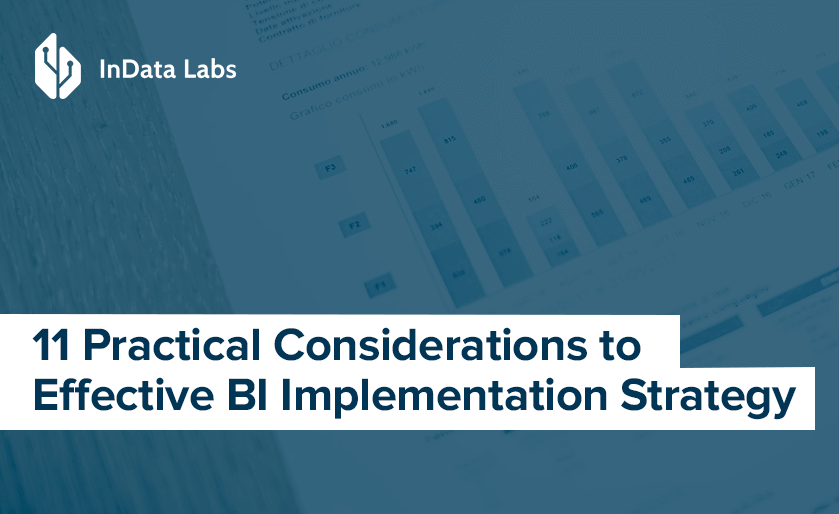In today’s business landscape, data and data intelligence is being rapidly scaled. Data is being applied in virtually every industry and decision-making process that makes up the corporate and for-profit realm.
Using Microsoft Power BI for marketing analytics (or a similar tool) is quickly becoming a vital prerequisite for any serious business. And the marketshare proves it: the worldwide BI and analytics market size reaches into the healthy billions. However, understanding and the complex world of business intelligence and implementing it effectively can sometimes seem convoluted and daunting.
Here is a simple guide that will help you dive in.
What is “Power BI marketing analytics”?
In order to understand the world of data collection and its application to business processes such as marketing analytics, let’s first break down some of these terms.
- “BI” refers to business intelligence. This encompasses the various models and tools for using data collection and analysis to inform business decisions.
- “Power BI” is a specific suite of Microsoft software tools available to achieve business intelligence and analytics. However, there are plenty of BI implementation methods and products available depending on your specific needs and application type.
- “Marketing analytics” is the process of applying BI concepts specifically to a business’s marketing strategy and processes.
As mentioned earlier, the business intelligence and analytics market is a vast landscape full of different tools, products, approaches, and philosophies about how to achieve information collection, analysis, data visualization, and more. These vary widely to accommodate the countless implementation types and needs that exist across the corporate ecosystem.

Source: Unsplash
However, there are a few forefront contenders for conducting marketing analytics for corporate entities.
What is the size of the business intelligence and analytics software market?
The business intelligence and analytics market size is expected to reach $18.5 billion U.S. dollars by 2026. This represents a growth rate of over 3% from 2021. BI and analytics softwares range in size and scope from free tools that are accessible to the individual, sole trader, and small business, all the way up to industrial software packages that cost many thousands per year and require dedicated servers and hardware just to operate.
There are a number of software types in the BI space that accommodate different needs and uses. Google analytics is a freemium offering that provides one good example of a simple, cloud-hosted SaaS product. This tool helps track simple things like digital marketing spend and performance, website traffic, and basic user experience metrics. A number of tools operate similarly. This is a light-touch, easy-entry offering that can provide small enterprises with basic data tracking and analytics functions.

Source: Unsplash
Other BI softwares are a bit more involved and make up a mid-tier range of options. From managing multiple data sources to being able to analyze larger or more complex amounts of business, financial, or marketing data, many BI softwares in this category are self-hosted (though not all). These options would come with a higher ticket price but would be able to accomplish much more robust analysis.
What is the difference between BI and marketing analytics?
Terms like business intelligence and marketing analytics can sometimes be used interchangeably, which can make it difficult to keep track of their nuances when researching options for your company or speaking with others in the industry. BI is an umbrella term that covers a range of applications and processes. Marketing analytics, on the other hand, refers to the application of BI principles specifically to marketing processes and performance.
This distinction is important when, for instance, deciding between softwares or evaluating implementation methods. Monitoring marketing campaigns or similar operations can necessitate very different tools than those that apply BI to, say, manufacturing or internal operations.

Source: Unsplash
It’s also important to distinguish BI and marketing analytics from other technological implementations and developments that can be similar and are sometimes confused. Automation, Artificial Intelligence (AI), and Machine Learning are terms that get thrown around in corporate and tech circles that can often get conflated.
Though these concepts have overlapping elements and conducting marketing analytics might increasingly incorporate elements of all three as technologies develop further, those are explained more in-depth in other resources and aren’t what we are referring to here.
Can using Power BI marketing analytics actually be effective?
There are likely thousands of data analytics services available around the globe that provide a wide range of marketing analytics and business intelligence functions. Implementations of these types of tools would be impossible to number. Virtually every business collects some kind of data, whether this is simply a customer database or a highly complex system that interacts with huge numbers of data sources. These days, it would be a shock to discover someone working in business that hasn’t heard of data analytics.
In theory, this huge majority of organizations around the world all applying BI for marketing analytics could fundamentally change the effectiveness and performance of any conceivable industry. And yet even with this monumentous flurry of data knowledge and activity, while countless organizations from every sphere may have some kind of BI mechanism in place, a huge percentage of these organizations aren’t able to maximize their value.
Collecting data is just a preliminary piece of the puzzle. Applying sound analytics and BI principles in order to extract insights and apply them to your business is another beast entirely.

Though (as mentioned previously) there are a number of software options on the market for marketing analytics, Microsoft’s Power BI suite can be a superior fit for a variety of needs and organization types. Its flexible family of tools can provide high levels of customization and versatility, and Microsoft’s deep experience with BI and data analytics has informed a premiere offering in the space.
How is BI used in marketing?
The vast analytics and BI market is constantly shifting as technology advances, data possibilities increase, and needs evolve. BI and analytics market trends tend to follow tech companies and trickle their way into other industries that are farther removed from cutting-edge technological implementation.
Though these strategies are constantly shifting, here are some sweeping elements that are almost always incorporated into BI marketing analytics processes.
Determining the Return On Investment (ROI) from marketing spend and resources
Without measuring pertinent metrics, a company who spends time and money on marketing efforts has very little way of intelligently determining whether those resources have been well-spent. It would be ludicrous to spend, especially repeatedly, on what may or may not be moving the business forward. Yet any company that spends funds or manpower on marketing its products or services without a mechanism in place to determine whether that spend achieved a positive return is doing just that.

Source: Unsplash
Sometimes these BI methods can be simple – if your company implemented a single marketing campaign and you only need to know whether that campaign affects the bottom line, that kind of research could be possible without any form of robust analytics. However, BI platforms and tools allow you to dissect large datasets or track outcomes when their indicators are more nuanced.
Better understanding customer interactions and needs through brand social media channels
BI tools can help your organization better identify your customers. Gathering usage trends and engagement data from your brand’s social media channels as well as other sources can contribute to a more robust and in-depth understanding of your ideal customer’s needs, wants, hopes, dreams, and fears.
This can significantly impact your ability to market effectively and connect with your audience. Analyzing engagement data from social media and similar can also help you optimize campaign types, lengths, channels, seasons, market subsets, and more.

Source: Unsplash
Researching competitor marketing campaigns to develop superior strategies or untapped markets
Data analysis and applications of BI mechanisms should be used not just with your own organization’s performance but to better understand what your competition is employing as well. This can be especially effective on social media, but can also be used to assess other forms of marketing.
Gaining insights on what your competitors are trying can help your company identify places in the market that aren’t as canvassed, find new segments you’ve not yet marketed to, and make sure your marketing campaigns are fresh and innovative.
Assessing large-scale market trends and happenings that might affect your organization or industry
For organizations in every industry, many trends that occur outside their purview or control can provide opportunities, warning signs, or insights that can significantly benefit their performance. Many organizations focus on their own internal operations and customer bases, leaving these sources of knowledge on the table.

Source: Unsplash
However, by keeping an eye on macro-scale happenings, organizations can sometimes not only uncover lucrative opportunities but save themselves huge calamities as well. Include a macro-discovery component in your BI strategy that watches for any worthwhile industry changes, regulatory shifts, geo-political happenings, local governance or competition developments, or general population trends that might affect your company or customers.
Keeping tabs on internal performance and identifying bottlenecks, inefficiencies, or problems
Business intelligence and data analysis isn’t just useful for outward or external insights. They can be hugely valuable tools for assessing your team or organization’s internal performance.
From monitoring individual performance to getting a better idea of how processes actually work and flow through your company from beginning to end, BI tools can help your team, decision-makers, executive suite, management, or entire organization better identify weaknesses and improve your internal performance health. Productivity audits, personal performance reviews, and internal monitoring can all benefit from incorporating robust data collection and analysis.

Source: Unsplash
Applying internal data analysis to your marketing team or department’s performance can skyrocket your organization’s marketing performance and efficacy over time. This can happen completely independent of implementing BI principles and mechanisms in your marketing performance analysis.
How do you gather marketing data?
Perhaps you’re interested conceptually in integrating more data analysis into your organization’s marketing processes. However, depending on how much data collection your organization currently implements, the question might remain: How do you get the data you need to actually implement business intelligence and marketing analytics?
Depending on the type of business you run, implementing data capture may be more or less difficult. Here are a few high-level strategies that can be adapted for just about any type of organization.
Utilizing Customer Relationship Management (CRM) systems
If you are already using a software platform (whether local or cloud-based) to manage your customer data, this is an excellent place to start. If you aren’t and you either keep your customer data by hand (on paper) or do not keep any customer data, there are many reasons it might be beneficial to consider converting to a digital CRM system.
Keeping your customer data digital rather than in hard-copy form can protect your business (as well as your customers) from losing that data in the case of theft or damage. It can make it much easier to integrate with any online presence you may have (for instance, a website or online business listings). It can also make it easier for your team to work with that data.
If you are already using a CRM for your customer data, this can provide a perfect jumpstart into employing BI techniques for your business. CRM tools can often integrate easily with a spectrum of BI and marketing analytics platforms and can provide a starting place for gleaning important insights.

Source: Unsplash
Integrating with social media platform data collection tools
Most social media platforms (e.g. Facebook, Instagram, LinkedIn, Twitter, and more) have business dashboards and features available. These tools may be free or paid. They expose more data than an individual might need or see. This data can be imported or integrated into a BI system of your choice.
Collaborate with vendors
Partners may be collecting information you aren’t. Be sure to abide by any privacy standards, but in applicable cases this can be a helpful source of data that is often overlooked.

Source: Unsplash
Start with what you have
This doesn’t have to start complicated or require paying for huge new software systems. Virtually every company has a lot more potential for data-driven marketing than they actually utilize.
Before looking outward, look inward. What data do your systems currently collect (whether this is digital or not)? What patterns and information could you glean from any information you already have? Look with new eyes at your current processes and you might find highly valuable strategies waiting to be implemented without adding new software.
Implementing Power BI in your marketing analytics and strategy
Whatever your organization needs, the process of changing systems or implementing new processes takes work and commitment. Here are a few tips to get the ball rolling if you want to implement a new or improved marketing analytics strategy.
Set deadlines
Don’t add something to a to-do list if it doesn’t come with a due date. This goes for both yourself and anyone else who will be involved in the process. Once you commit to building a marketing analytics program, attach a timeline and keep progressing.
Find out what analytics talent and understanding you have in your team or organization
You might be surprised at the talent you already have within your company or team. Just because you don’t currently have a formal analytics program doesn’t mean you have to start from scratch. Poll your employees and you could find a wealth of knowledge or even former professional experience in analytics systems.
Hire a data analyst, database specialist, or similar to build your marketing analytics program from the ground up.
Rather than struggling through creating one on your own or paying for expensive firms or consultations, depending on your organization’s needs and budget it may actually be more cost-effective to hire a specialist in this field to implement strategy for you.
Whether your organization ultimately decides to implement Microsoft’s Power BI, a similar BI software system, or any number of other mechanisms, tools, and processes to accomplish marketing analytics, you can rest assured that improving the quality of your marketing performance and decision-making can have a significant effect not only on your marketing but on your bottom line.
BI implementation for power up marketing analytics
Schedule an intro call with our consultants to explore your business needs and find out how we can help to achieve your goals.



